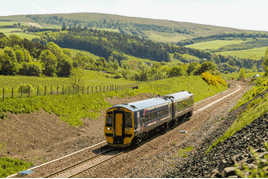Regarding tourism, Smith is keen to stress that Borders is not a rival destination to the likes of Edinburgh and the Highlands. She says: “We are not saying go to the Borders instead of other destinations. But we are promoting it as another option. It inspired Sir Walter Scott, and it is a very popular cycling destination. Plus we have the world-famous salmon fishing here…”
Mike Cantlay, chairman of VisitScotland, travelled on the VIP train on September 4, and barely contains his enthusiasm. He says of the re-opening: “It is of benefit to everyday business as well as tourism, and it works both ways.
“The tourist opportunity is massive. Edinburgh attracts millions of tourists each year and this gives them easier access to the region.
“The buzz that surrounds the re-opening is great. That the benefit to the economy is £35bn is not the main point - this is about putting the Borders back on the map.
“We are marketing it around the world. I think the level of tourism interest has come as a shock to the Borders. Before this, many people were wondering if anyone would want to come. We ourselves wondered about the interest for the launch, yet photographers were jumping off at stations to take pictures, and there is a train full of journalists.
“There are also steam trains and beautiful scenery. I think the trains will be fully booked, as will be the steam-hauled trains next year too. We may even have capacity issues. The steam trains will have big tourism potential.”
Already trains are full, and the steam specials occasionally clash with booked ScotRail trains, which means the booked service trains are cancelled in favour of the specials. This causes consternation as passengers are not able to use the ‘A4’-hauled trains, despite them being advertised as booked connections. Says Cantlay: “We will have to manage the clashes. The scenic railways and the demand for them is a game changer. Previously people have only seen trains as a means of getting from A to B, but that may now change.”
Many people give credit to the campaigners for the re-opening of the Borders Railway. They worked tirelessly to convice people that the line should be re-opened.
Campaign for Borders Rail called the re-opening “a unique achievement of grassroots campaigning.” CBR argues that the new railway stands out from other recent Scottish line re-openings because its original inspiration, and key elements of the final delivered scheme, came from the ideas and efforts of campaign groups.
CBR’s UK Parliamentary Officer Nick Bethune says: “The Borders Railway should be recognised as one of the greatest achievements of grassroots rail campaigning in British history.
“Other route re-openings in recent years in Scotland - Larkhall, Alloa and Airdrie-Bathgate - have essentially been ‘top down’ schemes, conceived and planned by local and/or central government. But the origins of the railway to Galashiels and Tweedbank can be traced back to the vision of Borders-based Simon Longland back in the early 1990s.
“This led on seamlessly to the founding of CBR in 1998, and under the inspired leadership of our first chairman, Petra Biberbach, campaigners played a big part in persuading Borderers that they really could get their railway back - generating a 17,200 signature petition which was handed to the Scottish Parliament
“There hasn’t been a bigger reversal of a Beeching cut anywhere in Britain, and a whole region that was cut off from the rail network is now back on the railway map. Most other route re-openings have been essentially suburban in character - but the Borders Railway is very different, and nothing quite like this has ever been done before. This is a credit not just to campaigners, but also to local and central government, and to the rail industry.”
Bethune continues: “As well as the core strategic achievement of the return of a railway from Edinburgh through Midlothian to Tweedbank, local rail campaigners can take credit for some important supporting successes, a number of them achieved in the face of official resistance.
“For example, we persuaded Parliament to include a station stop at Stow when none was to be provided, and it was our initiative which led to the saving of the original 1849 station building at Stow from demolition.
“Crucially, years of research and lobbying by us - plus the input of Claudia Beamish MSP - convinced Transport Minister Keith Brown in 2012 that the Tweedbank station track layout should be re-designed to take 12-coach tourist trains, providing the basic infrastructure needed to bring additional tourist spend to the Borders.
“More recently, we persuaded Transport Scotland that the Borders Railway Class 158 trains should be refurbished to provide a better experience for commuters and tourists.
“The new railway offers much more than it would have done without the efforts of hundreds of unpaid campaigners over the last 17 years.”
The mantra at the launch was very much: “The journey begins today, but it will be for the benefit of generations to come.” That sums up the scheme pretty well.
- This feature was published in the Scottish Supplement of RAIL 783 (September 16 - 29 2015)















Login to comment
Comments
No comments have been made yet.